Cold Chain Logistics Stocks: BioLife vs Cryoport
Table of contents
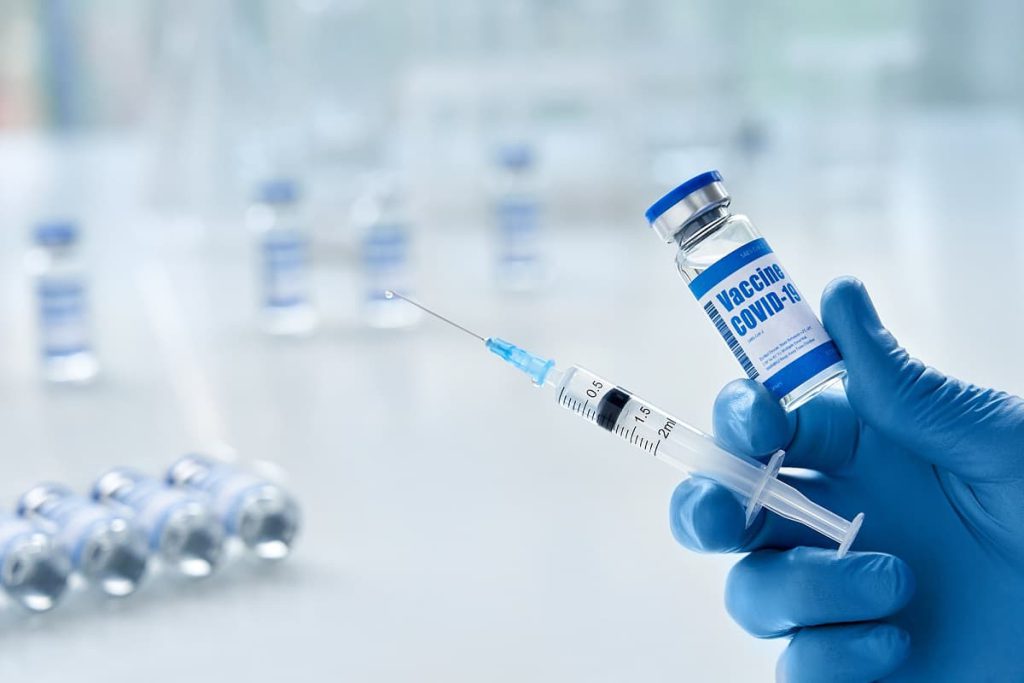
A few months ago, we held a cage match between two of the leading gene-editing stocks. Basically, it ended in a draw, leaving us with a mini portfolio in this potentially lucrative but extremely volatile life sciences/nanotech market. Generally risk-averse investors, we’re always looking for ways to get exposure to an emerging technology theme like gene editing through ancillary avenues. Often referred to as pick-and-shovel plays, these are the “more boring” businesses that offer goods and services that support the main industry in question. For example, directly investing in cannabis remains risky because you’re selling weed in markets with a lot of hazy legal issues. But perfectly law-abiding pick-and-shovel plays like hydroponics equipment for growing weed might be an indirect but safer longer-term bet as the bud industry continues to blossom.
So, let’s see if we can warm up to a couple of pick-and-shovel businesses coalescing around the rapidly growing cell and gene therapy market.
Cold Chain Logistics in Biotech
Remember, covid? If so, you may recall that the mRNA vaccines need to remain ridiculously cold until just before they are ready to be used. Well, there’s a whole business platform built around temperature-controlled logistics for not just processing, storing, and transporting vaccines, but for all of the biological bits and bobs that life science companies, research institutes, universities, and your occasional evil genius develop. In this case, we’re going to zero in on two companies that are probably the biggest pure plays in cold chain logistics for cell and gene therapies – Cryoport (CYRX) and BioLife Solutions (BLFS).
The Cell and Gene Therapy Market
First, however, let’s try to wrap our arms around the size of this potential market before we tackle specifics around Cryoport and BioLife. Today, most cell and gene therapies generally fall into the category of regenerative medicine, which is all about using and modifying the body’s own micro machinery to repair or restore the parts no longer under warranty. These technologies include everything from bioengineering blood vessels to cancer immunotherapies, often using tools from synthetic biology, a game-changing science discipline in our opinion. Zooming even further out: Regenerative medicine is one of the primary pathways for increasing longevity, a healthcare industry some have claimed will be worth more than $1 trillion someday.
Well, that day is definitely not today. Instead, we’re left with the usual drivel of unreliable market reports churned out by content factories overseas. That’s possibly where the market numbers for this chart from BioLife came from, suggesting a total addressable market (TAM) of about $14 billion for the various links in cold chain logistics in which the company operates:
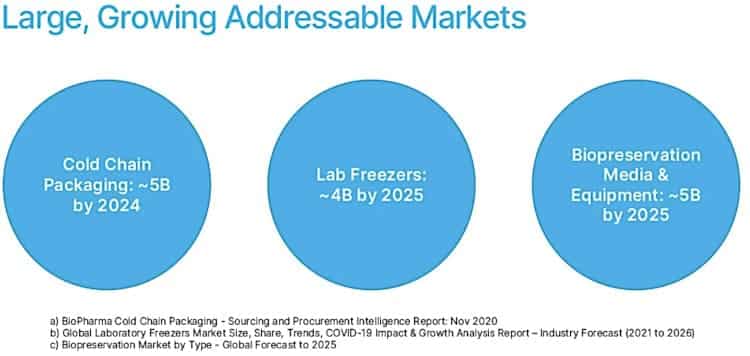
A couple of slides we like better come from the Alliance for Regenerative Medicine (ARM), an advocacy group that puts together market data and other relevant stats. Over the last five years, for instance, ARM estimates investors have poured more than $70 billion into regenerative medicine and other advanced therapies.
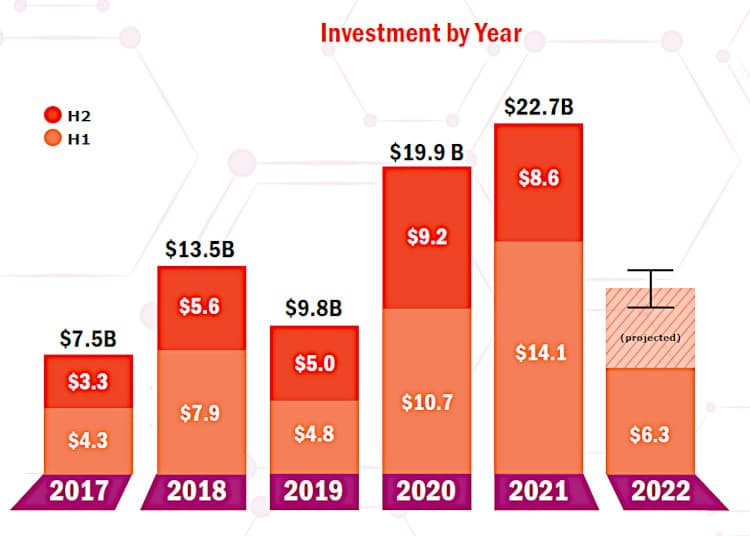
In addition, there are more than 2,000 clinical trials for regenerative medicine under way, with nearly 1,400 companies, research institutes, universities, and others (even evil geniuses do R&D) developing cell, gene, and tissue-engineering therapies. However, it’s also worth noting that the number of clinical trials are down in the first half of the year, but more importantly, funding has dropped back significantly.
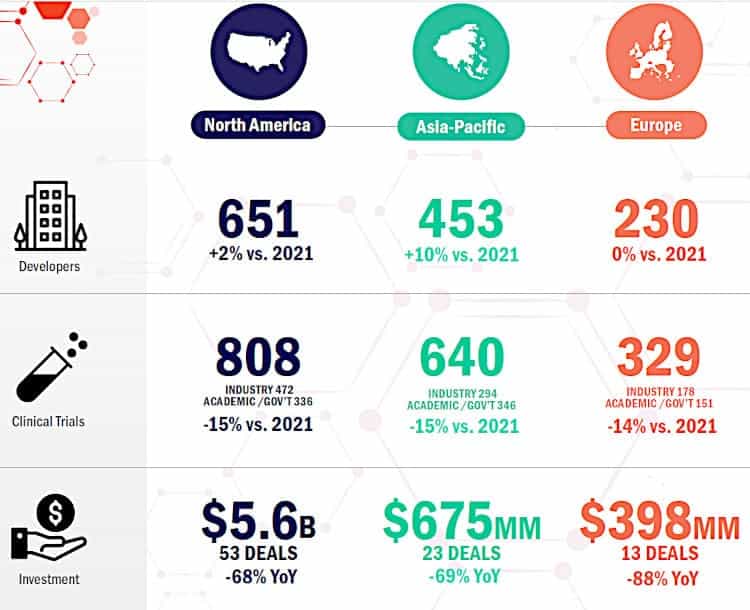
Putting a real number to the TAM is beyond our ability here, but based on the activity in the regen-med sector – including steady regulatory approvals for gene and cellular therapies from both the United States and Europe – those numbers from BioLife could be within the ballpark of possibility in the next few years.
About BioLife Solutions Stock
So, let’s start with BioLife then, a company based out of the greater Seattle metro area that was incorporated nearly 25 years ago from its “humble beginning with novel biopreservation media products but few customers and limited financial resources.” It went public way back in 2002 as an OTC stock but uplisted to the Nasdaq in 2014. Today, BioLife has a market cap of just over $1 billion, with total revenue of $119.2 million in 2021, an increase of 148% from a year ago. That kind of growth certainly catches our attention, but there are nuances to consider.
BioLife Acquisitions
As we understand it, BioLife started life more on the biopreservation side of things but recently has made a number of acquisitions to build out an entire cold chain logistics platform to compete against Cryoport, a company we’ll cover in depth later. Since 2019, it has acquired a half dozen new companies, which have driven a sixfold increase in 2018 revenue of nearly $20 million. BioLife now tracks three revenue lines:

As you can see, revenues have shot up and diversified greatly over the last couple of years thanks to these new additions. In 2021, for instance, freezer and thaw revenues increased 318% largely thanks to its acquisitions of Global Cooling and Sexton. The former manufactures ultra-low temperature freezers and the latter produces various tools and products to process and freeze different types of biological materials.

The pop in 2020 revenue can be attributed to a full year of revenues from its 2019 acquisition of Custom Biogenic Systems, which designs and manufactures liquid nitrogen laboratory freezers, cryogenic equipment, and accessories. SciSafe, another biostorage company, also started contributing to the bottom line in 2020. The addition of SAVSU Technologies and its cloud-based tools for tracing and tracking biologic products like cell and gene therapies was a key move to kickstart BioLife’s expansion into cold chain management. Finally, the 2019 acquisition of Astero Bio Corporation added new thawing technology.
BioLife Stock in 2021-22
One thing we like about BioLife is that the company does a good job breaking down organic growth against its recent acquisitions and other revenue outliers. For instance, in 2021, it had organic revenue growth of 37%, while covid-related revenue accounted for 15% of total revenue. In the first half of this year, total revenue hit $76.8 million, an increase of 60% from $48.1 million for 2021, with organic revenue increase of 45%. Covid-related revenue accounted for about 9% of total revenue. So growth remains strong, even as the pandemic economic pump starts to run dry.
Some other encouraging stats: The company added more than 200 new direct customer sites. To date, its biopreservation media products have been incorporated in more than 530 customer clinical applications, including numerous chimeric antigen receptor (CAR)-T cells and other cell types that we’ve talked about before regarding cancer immunotherapies. Those applications include 10 approved cell and gene therapies, with at least 10 additional therapies expected to be submitted for regulatory approval in 2022 and 2023. Each commercial application is worth between $500,000 and $2 million annually, according to BioLife.

There are also the typical growing pains. The Global Cooling deal cost $235 million, and BioLife just took a one-time loss (also known as a goodwill impairment) of almost $70 million after the accountants re-crunched the numbers because of supply chain issues with the ultra-low temperature freezers and a pivot away from developing an early-stage product from Global Cooling. No doubt there will be more bumps in the road as BioLife integrates all of these new companies, but hopefully, it won’t be the trainwreck experienced by 3D-printing company Stratasys during its buying spree. Another red flag: At the end of 2021, one customer accounted for 17% of total revenues. In addition, BioLife is heavily reliant on U.S. business, with 78% of revenues concentrated in the States.
About Cryoport Stock
Cryroport doesn’t have the same customer concentration issues but the company has its own challenges. Like BioLife, it also has a history that goes back to before the turn of the 21st century and more humble beginnings. The California company out of Orange County was originally founded by a bunch of doctors looking for better cryogenic options than dry ice for shipping sensitive biological specimens. By 2005, it had gone public as an OTC stock, eventually uplisting a decade later to the Nasdaq in 2015. Today, it has a market cap of about $1.6 billion and its cold chain logistics operation had 2021 revenue of $222.6 million, representing 183% year-over-year growth. And, similar to BioLife, most of that growth can be attributed to a bunch of acquisitions since 2019.
Cryoport Acquisitions
However, while BioLife originally focused on biopreservation media, Cryoport made its cash with cryogenic shipping services for biopharma, reproductive medicine, and animal health markets (the latter two could just be consolidated into animal reproduction services). And that’s still how the company breaks down revenue today, despite adding eight new businesses in the last few years that are hyperfocused on cell and gene therapy – so many, so quickly that we actually had to revise that number twice three times before publishing.

It started in May 2019 with the acquisition of Cryogene Labs, a temperature-controlled biostorage solutions business based out of Houston that helped more than double revenue from about $34 million in 2019 to nearly $79 million in 2020. In 2020, BioLife acquired two more companies. In CRYOPDP, Cryoport added 22 logistics centers in 12 countries to its global network of temperature-controlled support solutions. It also provided the cloud-based logistics platform necessary to manage these complex cold chains. The other 2020 acquisition, MVE, provides cryobiological storage and transportation systems using expensive-sounding equipment like cryogenic stainless-steel freezers and aluminum dewars.
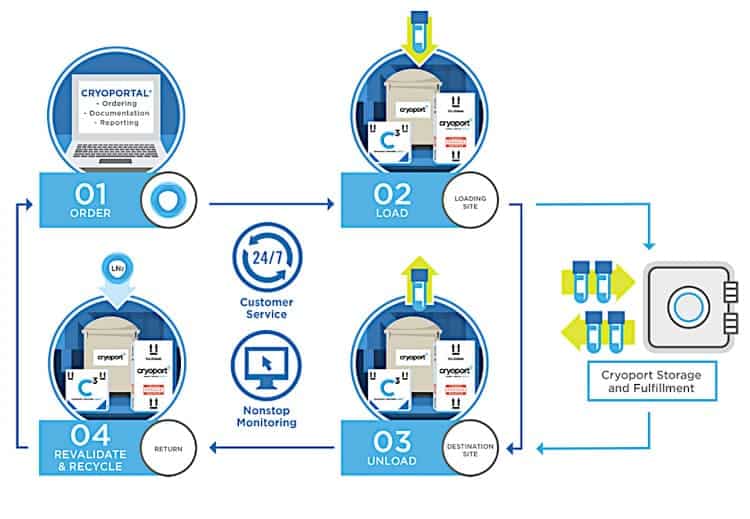
MVE represented Cryoport’s aggressive push to grab market share in the rapidly growing cell and gene therapy business both domestically and overseas, with a key location in Chengdu, China. Cryoport is definitely doing the better job building its business internationally. That’s further reflected in its two 2021 acquisitions in the second quarter – Critical Transport Solutions Australia in Australia and F-airGate in Belgium – that the company says will further bolster its global temperature-controlled supply chain capabilities in Europe and Asia. Ditto for its latest acquisitions in 2022, Cell&Co BioServices in France and Cell Matters in Belgium.
Cryoport Stock in 2021-22
Indeed, you can see how quickly Cryoport diversified its business geographically since 2019:

Today, the combined Cryoport conglomerate has 33 facilities in 15 countries. It supports more than 600 clinical trials and nine commercial therapies globally. In addition, this year the company is launching a new Bioservices business that will oversee its equally new Supply Chain Centers that will offer “a fully new and integrated approach designed to support cell and gene therapies including comprehensive controlled temperature storage, fulfillment, kit production, secondary packaging, labeling of therapeutic products and GMP raw materials storage.”
Cryoport claims to have $550 million in cash and short-term investments, though the math seems a bit fuzzy to us. That’s because most of the money in those investments didn’t exist before 2021, so presumably, some shareholder dilution and debt occurred along the way. In fact, the company holds about $480 million in debt. And, like BioLife, we’re doubtful that the fallout from the buying spree has yet to settle.
BioLife Stock vs Cryoport Stock
It’s funny to think that these two companies have been on a slow-moving collision course for more than 20 years. The rapid rise of cell and gene therapy technologies appeared to spur both to action in 2019 with a spate of acquisitions meant to strengthen their position in the cold chain logistics space. Both are essentially banking on a big payout from the cell and gene therapy market as more products receive approval. Each has core competencies – BioLife in cryo tech, Cryoport in shipping logistics – but those differences are attenuating over time as they bolt on new companies. It would be hard to pick a winner based on the numbers below:
| BioLife | Cryoport | |
| Market Cap | $1.1B | $1.6B |
| 2021 Revenue | $119.2M | $222.6M |
| 2022 Projected Revenues | $160M-$166M | $260M-$265M |
| H1-2022 Gross Margin | 43.9% | 31% |
| 2022 Simple Valuation Ratio | 6.88 | 6.15 |
| Clinical Applications/Trials | 530 | 626 |
| Cell & Gene Therapy Programs | 10 | 9 |
Both companies also support a number of the same big names in the pharma industry. This slide is from BioLife, but Cryport probably has a similar one:

Cryoport probably gets the edge thanks to its larger size and international presence. While it also has a better (not great) gross margin, that’s mainly because the Global Cooling acquisition for BioLife has proven to be less profitable.
Conclusion
And that last point is one reason why we would not invest in either company right now, despite the hype around cell and gene therapies: Both companies have yet to completely integrate and consolidate their new holdings. We need to see what other skeletons fall out of the closet first. In addition, there are economic indicators – less investment, fewer clinical trials – that the market is cooling off a bit. How will the growth stories play out once the acquisition mania slows down? (And, for Cryoport, that may not happen any time soon, as the company has indicated there are more to come.) For now, we’re happy to chill out and see what happens.











Thank you for the analysis.
I hadn’t heard of BioLife but I have stock in Cryoport since the Pandemic started. Stock is not doing well but I am holding on.
Regards
Eva
Thank you for the comment Eva. Good to know about both these companies given they’re quite similar.